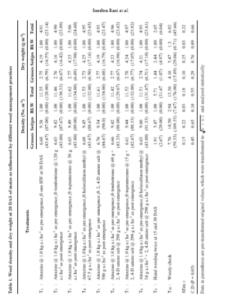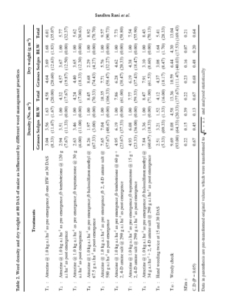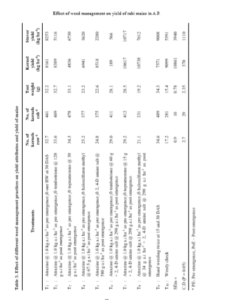EFFECT OF WEED MANAGEMENT PRACTICES ON WEED GROWTH AND YIELD OF RABI MAIZE IN SCARCE RAINFALL ZONE OF ANDHRA PRADESH
0 Views
B. SANDHYA RANI*, V. CHANDRIKA, G. PRABHAKARA REDDY, P. SUDHAKAR, K.V. NAGAMADHURI AND G. KARUNA SAGAR
Assistant Professor, Department of Agronomy, S.V. Agricultural College, Tirupati – 517 502, Andhra Pradesh
ABSTRACT
Field experiment was conducted during rabi, 2017-18 at wetland farm of S.V. Agricultural College, Tirupati, Andhra Pradesh. The experiment was laid out in a randomized block design with three replications. There were 10 treatments consisting of pre emergence application of atrazine @ 1.0 kg a.i ha-1 fb post emergence application of tembotrione @ 120 g, topramezone @ 30 g, halosulfuron methyl @ 67.5 g, 2, 4-D amine salt @ 580 g, tembotrione @ 60 g + 2, 4-D amine salt @ 290 g, topramezone @ 15 g + 2, 4-D amine salt @ 290 g, halosulfuron methyl @ 34 g a.i ha-1 + 2, 4-D amine salt @ 290 g a.i ha-1, pre emergence application of atrazine @ 1.0 kg a.i ha-1 fb one HW at 30 DAS, hand weeding twice at 15 and 30 DAS and control. The results revealed that broad-spectrum weed control and higher kernel yield of maize was recorded with hand weeding twice at 15 and 30 DAS, which was however comparable with application of atrazine @ 1.0 kg a.i ha-1 as pre emergence fb topramezone @ 30 g a.i ha-1 as post emergence and atrazine @ 1.0 kg a.i ha-1 as pre emergence fb tembotrione @ 120 g a.i ha-1 as post emergence without any significant disparity among them.
KEYWORDS:
Chemical weed management, maize, yield, weed dry weight
INTRODUCTION
Maize is the third most economically important cereal crop after rice and wheat. It is a miracle crop being used as a food and feed as well as preparation of vast industrial products like starch, oil, protein, alcoholic beverages, food sweeteners, Pharmaceutical, cosmetic, textiles, package and paper industries. Over 85 per cent of corn produced in our country is consumed directly as food in various forms like roasted cobs, popcorns, chapattis, corn flakes etc. Among the different production constraints, weeds were the important biological production constraints which limit the yield of maize. Weed infestation is supreme importance among biotic factors that are responsible for low maize grain yield. Worldwide maize production is hampered upto 40% due to competition from weeds which are the most important pest group of this crop.
Generally weeds reduce crop yields by competing for light, nutrients, water and carbon dioxide as well as interfering with harvesting and increasing the cost involved in crop production. Overall, weeds impose the highest loss potential (37%), which is higher than the loss potentials due to animal pests (18%), fungal and bacterial pathogens (16%) and viruses (2%) (Tesfey etal., 2014). The critical period for weed control starts from four to six leaf stage and continues until ten leaf stage or flowering of corn (Gantoli et al., 2013). Control of weeds in the fields of maize is, therefore, very essential for obtaining good crop harvest. Weed control practices in maize resulted in 77 to 96.7 per cent higher grain yield than the weedy check. Hand weeding is most popular among the farmers for weed control but it is expensive, laborious and time-consuming. In the developing countries like India acute shortage for labour occurs where the peak labor requirement is often for hand weeding. Herbicides weed control is an important alternative to manual weeding because it is cheaper, faster and gives better weed control. At present pre emergence herbicides especially atrazine is being used continuously for control of weeds in maize that leads to shift in emergence of weed pattern in crop and cropping system. Therefore farmers are in need of early post emergence herbicides for effective control of weeds at 15 to 25 days of crop where weeds offer severe competition for resources. Keeping this in view, present investigation was carried out to study the effect of sequential application of pre and post emergence herbicides on weeds, growth and yield in maize.
Effect of weed management on yield of rabi maize in A.P.
MATERIALS AND METHODS
The field experiment was conducted during rabi, 2017-18 at wetland farm of S.V. Agricultural College, Tirupati, which is geographically situated at 13.6°N latitude and 79.3°E longitude, at an altitude of 182.9 m above the mean sea level in the Southern Agro-Climatic Zone of Andhra Pradesh, India. The soil of the experimental site was sandy clay loam in texture, neutral in soil reaction, low in organic carbon (0.25%) and available nitrogen (174 kg ha-1), medium in available phosphorus (20.5 kg ha-1) and potassium (186 kg ha-1). The experiment was laid out in randomized block design with ten treatments replicated thrice viz., atrazine @ 1.0 kg a.i ha-1 as pre emergence fb one HW at 30 DAS (T1), atrazine @ 1.0 kg a.i ha-1 as pre emergence fb tembotrione @ 120 g a.i ha-1 as post emergence (T2), atrazine @ 1.0 kg a.i ha-1 as pre emergence fb topramezone @ 30 g a.i ha-1 as post emergence (T3), atrazine @ 1.0 kg a.i ha-1 as pre emergence fb halosulfuron methyl @ 67.5 g a.i ha-1 as post emergence (T4), atrazine @ 1.0 kg a.i ha-1 as pre emergence fb 2, 4- D amine salt @ 580 g a.i ha-1 as post emergence (T5), atrazine @ 1.0 kg a.i ha-1 as pre emergence fb tembotrione @ 60g + 2,4-D amine salt @ 290 g a.i ha-1 as post emergence (T6), atrazine @ 1.0 kg a.i ha-1 as pre emergence fb topramezone @ 15 g + 2, 4-D amine salt @ 290 g a.i ha-1 as post emergence (T7), atrazine @ 1.0 kg a.i ha-1 as pre emergence fb halosulfuron methyl @ 34 g a.i ha-1 + 2, 4-D amine salt @ 290 g a.i ha-1 as post emergence (T8), hand weeding twice at 15 and 30 DAS (T9) and control (T10). Bold and healthy certified seeds of maize hybrid DHM – 117 was sown by dibbling at a spacing of 60 cm × 20 cm with the seed rate of 15 kg ha-1 on 19th November, 2017, with a plot size of 5.4 m × 4. 6 m. Recommended dose of 240 kg N, 80 kg P2O5 and 80 kg K2O ha-1 was supplied through urea, single super phosphate and muriate of potash to all the plots, respectively to all the plots of maize uniformly. Pre emergence herbicide was applied within 24 hours after sowing and early post emergence herbicides were applied at 21 DAS of maize.
The weed population was counted with the help of 0.5 m × 0.5 m quadrant thrown randomly at two places in each plot and converted to population or density per m-2. While recording weed population, the biomass was harvested from each quadrant. The different species of weeds collected for assessing the density of weeds were dried separately in hot air oven at 65ºC till constant dry weight was reached and converted in to gm-2. Five randomly selected plants were tagged in each treatment, from each replication in the net plot area and used for making observations on various growth parameters and yield attributes of maize. Due to large variation in values of density and dry weight of weeds, the corresponding data was subjected to square root transformation (“0.5 + x) and the corresponding transformed values were used for statistical analysis as suggested by Gomez and Gomez (1984).
RESULTS AND DISCUSSION
Weed floral composition of the experimental site:
The predominant weed species in the experimental site were Brachiaria ramosa, Cyanodon dactylon, Dactyloctenium aegyptium (L) Beauv, Digitaria sanguinalis (L.) scop, Cyperus rotundus L, Boerhavia erecta L, Borreria hispida (L.) K. Schum, Celosia argentea L., Cleome viscosa L., Clitoria ternata L., Commelina benghalensis L., Corchorus aestuans L., Digera arvensis, Euphorbia hirta L., Phyllanthus niruri L., Trichodesma indicum L. and Tridax procumbens L.
Weed density and dry weight at 20 DAS
Hand weeding twice at 15 and 30 DAS (T9), registered significantly lower density and biomass of grasses and sedges, whereas weedy check (T10) recorded significantly higher density and dry weight of weeds than rest of all the treatments (Table-1). Among the various weed management practices tried, significantly higher density and dry weight of broad leaved weeds was noticed with weedy check (T10). The density and dry weight of total weeds at 20 DAS was significantly lowest with hand weeding twice at 15 and 30 DAS (T9). The rest of the weed management practices were par with each other in the order of ascent in recording weed density and weed biomass.
Weed density and dry weight at 80 DAS
Hand weeding twice at 15 and 30 DAS (T9) recorded significantly lower density and dry weight of grassy weeds which was closely followed by atrazine @ 1.0 kg a.i ha-1 as pre emergence fb topramezone @ 30 g a.i ha-1 as post emergence (T3), atrazine @ 1.0 kg a.i ha-1 as pre emergence fb tembotrione @ 120 g a.i ha-1 as post emergence (T2) and atrazine @ 1.0 kg a.i ha-1 as pre emergence fb one HW at 30 DAS (T1), without any significant disparity among themselves. The next best treatments in suppressing the grass count was atrazine @ 1.0 kg a.i ha-1 as pre emergence fb topramezone @ 15 g + 2, 4-D amine salt @ 290 g a.i ha-1 as post emergence (T7), atrazine @ 1.0 kg a.i ha-1 as pre emergence fb tembotrione @ 60 g + 2, 4-D amine salt @ 290 g a.i ha-1 as post emergence (T6), which were significantly lower than atrazine @ 1.0 kg a.i ha-1 as pre emergence fb 2, 4-D amine salt @ 580 g a.i ha-1 as post emergence (T5), atrazine @ 1.0 kg a.i ha-1 as pre emergence fb halosulfuron methyl @ 34 g a.i ha-1 + 2, 4-D amine salt @ 290 g a.i ha-1 as post emergence (T8), without any significant disparity between them, but recorded statistically lower density of grasses than atrazine @ 1.0 kg a.i ha-1 as pre emergence fb halosulfuron methyl @ 67.5 g a.i ha-1 as post emergence (T4). Effective control of sedges with recommended dose and half of the recommended dose of halosulfuron methyl, with no effect on grasses favoured to increase grass count in the field. The highest density and dry weight of grasses was registered with weedy check (T10), than rest of the weed management practices tried (Table-2).

Effect of weed management on yield of rabi maize in A.P.
Sedge count and dry weight were significantly lower with atrazine @ 1.0 kg a.i ha-1 as pre emergence fb halosulfuron methyl @ 67.5 g a.i ha-1 as post emergence (T4). This might be owed to the fact that halosulfuron methyl is effective in reducing the sedge count than other pre or post emergence herbicides. Hand weeding twice at 15 and 30 DAS (T9), atrazine @ 1.0 kg a.i ha-1 as pre emergence fb halosulfuron methyl @ 34 g a.i ha-1 + 2,4D amine salt @ 290 g a.i ha-1 as post emergence (T8), atrazine @ 1.0 kg a.i ha-1 as pre emergence fb topramezone @ 30 g a.i ha-1 as post emergence (T3), atrazine @ 1.0 kg a.i ha-1 as pre emergence fb tembotrione @ 120 g a.i ha-1 as post emergence (T2) and atrazine @ 1.0 kg a.i ha-1 as pre emergence fb one HW at 30 DAS (T1) were the next best treatments in reducing the sedge density and dry weight without any significant disparity among themselves.
Atrazine @ 1.0 kg a.i ha-1 as pre emergence fb topramezone @ 15 g + 2, 4-D amine salt @ 290 g a.i ha1 as post emergence (T7) and atrazine @ 1.0 kg a.i ha-1 as pre emergence fb tembotrione @ 60 g + 2, 4-D amine salt @ 290 g a.i ha-1 as post emergence (T6) were comparable with one another and recorded significantly lower sedge count and dry weight than atrazine @ 1.0 kg a.i ha-1 as pre emergence fb 2, 4-D amine salt @ 580 g a.i ha-1 as post emergence (T5) and unweeded check (T10).
Weedy check (T10) recorded significantly higher broad leaved weed count than all other weed management practices. Hand weeding twice at 15 and 30 DAS (T9) and atrazine @ 1.0 kg a.i ha-1 as pre emergence fb one HW at 30 DAS (T1) were comparable with one another and recorded significantly lower broad leaved weed count than weedy check (T10). Broad leaved weed count was not recorded in the rest of the weed management practices during the two consecutive years of study. This was mainly due to the fact that pre emergence application of atrazine @ 1.0 kg a.i ha-1 showed a greater impact in controlling the broad leaved weeds not only in the initial stages but also at later stages of crop growth.
The total weed population and dry weight at 80 DAS was the lowest with hand weeding twice at 15 and 30 DAS (T9), which was however, at par with atrazine @ 1.0 kg a.i ha-1 as pre emergence fb topramezone @ 30 g a.i ha-1 as post emergence (T3), atrazine @ 1.0 kg a.i ha-1 as pre emergence fb tembotrione @ 120 g a.i ha-1 as post emergence (T2) and atrazine @ 1.0 kg a.i ha-1 as pre emergence fb one HW at 30 DAS (T1), without any significant disparity among the treatments. Lowest density of total weeds at 80 DAS was mainly attributed to the reason that effective control of weeds with two hand weedings or sequential application of herbicides caused marked reduction in density of weeds at all the stages of crop growth. Similar results were reported by Kumar et al. (2013) and Singh et al. (2012). The total weeds count and dry weight was significantly higher with weedy check (T10). Similar results of higher density and dry weight of weeds in weedy check were noticed with Puscal et al. (2018).
Yield attributes and yield
Hand weeding twice at 15 and 30 DAS (T9) recorded significantly higher number of kernels row-1 , number of kernels cob-1, test weight, kernel and stover yield of maize which was found to be on par with atrazine @ 1.0 kg a.i ha-1 as pre emergence fb topramezone @ 30 g a.i ha-1 as post emergence (T3), atrazine @ 1.0 kg a.i ha-1 as pre emergence fb tembotrione @ 120 g a.i ha-1 as post emergence (T2) and atrazine @ 1.0 kg a.i ha-1 as pre emergence fb one HW at 30 DAS (T1), which in turn were comparable with another among the treatments (Table3). It might be due to minimum crop-weed competition throughout the crop growing period as evident by lowest density and dry weight of weeds which favoured better utilization of nutrients, moisture, light and which in turn


might increased the yield attributes of maize. The next best treatments in recording higher yield attributes and yield of maize were atrazine @ 1.0 kg a.i ha-1 as pre emergence fb topramezone @ 15 g + 2, 4-D amine salt @ 290 g a.i ha-1 as post emergence (T7) which was at par with atrazine @ 1.0 kg a.i ha-1 as pre emergence fb tembotrione @ 60 g + 2, 4-D amine salt @ 290 g a.i ha-1 as post emergence (T6) and were significantly superior to atrazine @ 1.0 kg a.i ha-1 as pre emergence fb halosulfuron methyl @ 67.5 g a.i ha-1 as post emergence (T4) and atrazine @ 1.0 kg a.i ha-1 as pre emergence fb 2, 4-D amine salt @ 580 g a.i ha-1 as post emergence (T5), which inturn were comparable with one another.
The yield attributes were significantly lowest with control (T10). The lowest values of yield components in control might be due to severe stiff competition for both above and below ground resources. Similar results were reported by Kamble et al. (2015) and Hajji et al. (2012).
LITERATURE CITED
Gantoli, G., Victor, R.A and Ronald, G. 2013. Determination of the critical period for weed control in corn. Weed Technology. 27(1): 63-71.
Gomez, K.A and Gomez, A.A. 1984. Statistical Procedure for Agricultural Research. International Rice Research Institute, Manila, Philippines.
Kamble, A.S., Yogeesh, L.N., Prashanth, S.M., Channabasavanna, A.S and Channagoudar, R.F. 2015. Effect of weed management practices on weed growth and yield of maize. International Journal of Science, Environment and Technology. 4(6): 15401545.
Kumar, B., Kumar, R., Kalyani, S and Haque, M. 2013. Integrated weed management studies on weed flora and yield in kharif maize. Trends in Biosciences. 6(2): 161-164.
Puscal, S., Buddhadeb, D and Raghavendra, S. 2018. Tank mix application of tembotrione and atrazine to reduce weed growth and increase productivity of maize. Indian Journal of Weed Science. 50(3): 305-308.
Singh, V.P., Guru, S.K., Kumar, A and Banga, A. 2012. Bio efficacy of tembotrione against mixed weed complex in maize. Indian Journal of Weed science. 44(1): 1-5.
Tesfay, A., Amin, M and Mulugeta, N. 2014. Management of weeds in maize (Zea mays L.) through various pre and post emergence herbicides. Advances in Crop Science and Technology. 2: 151-156.
- Genetic Divergence Studies for Yield and Its Component Traits in Groundnut (Arachis Hypogaea L.)
- Correlation and Path Coefficient Analysis Among Early Clones Of Sugarcane (Saccharum Spp.)
- Character Association and Path Coefficient Analysis in Tomato (Solanum Lycopersicum L.)
- Survey on the Incidence of Sesame Leafhopper and Phyllody in Major Growing Districts of Southern Zone of Andhra Pradesh, India
- Effect of Organic Manures, Chemical and Biofertilizers on Potassium Use Efficiency in Groundnut
- A Study on Growth Pattern of Red Chilli in India and Andhra Pradesh

